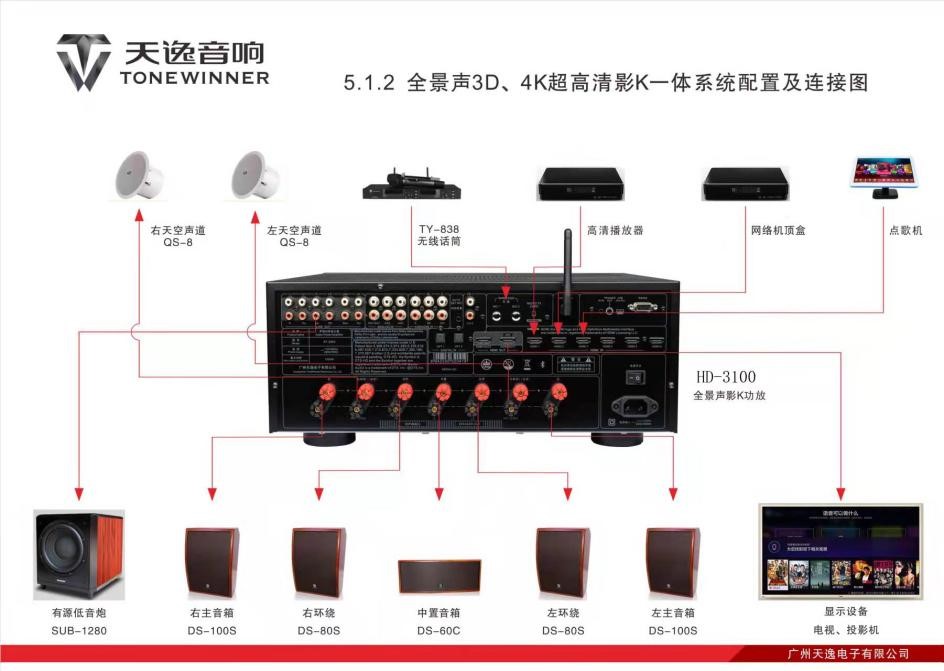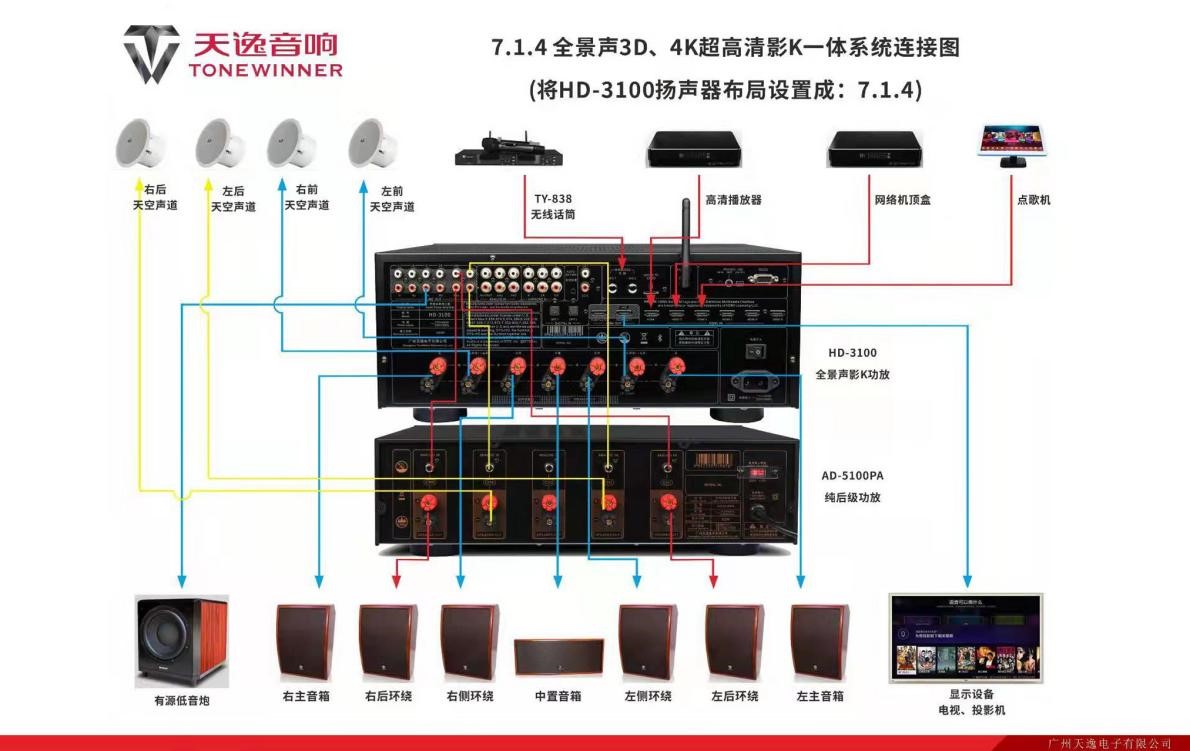Tonewinner AT-2300 or other Dolby Atmos decoding products first-time installation and adjustment
Let's take Tonewinner AT-2300 theater and Karaoke integrated power amplifier as an example, and show you how to do the first-time installation and adjustment after you get Tonewinner's amplifiers.
The first step is to connect the sound system properly.

This is a 5.1.2 system.

This is a 7.1.4 system.
After the system is connected properly, we can control the machine in two ways, by using a remote control or by buttons on the front panel. In this video, we will use the remote control to control the adjustment.
1 Speaker layout settings
Open the [Setup] - [Speaker setup] - [Speaker layout]. There are multiple built-in speaker layout modes. You can choose different speaker layouts according to the number of speakers.
2 Level test/compensation
Open the [Setup] - [Speaker setup] - [Level test/adjust]. Adjust each channel one by one, and each channel will emit a pink noise signal. This test can check whether the wiring of each speaker is correct and whether the level gain of each speaker is consistent.
3 Speaker distance (delay) settings
Open the [Setup] - [Speaker setup] - [Speaker distance]. Enter the best distance from each speaker to the sitting position, and the system automatically converts it into milliseconds (delay time) to achieve a better listening effect.
4 Subwoofer selection settings
Open the [Setup] - [Speaker Setup] - [Subwoofer], and the [Subwoofer] option is grayed out at this time, because the system forces the subwoofer to be turned on. If you want to turn off/on the subwoofer, you need to select [Speaker crossover] - [L/R crossover], and set the left and right channels to [Bypass]. At this time, the [Subwoofer] option is brightened, and you can turn on/off the subwoofer.
This setting is to avoid turning off the subwoofer by mistake when the main speaker is not set to full frequency [Bypass], resulting in loss of subwoofer signal.
5 EQ settings
Open the [Setup] - [Manual EQ]. The EQ settings provide a variety of effect modes. After selecting the theater mode EQ1, you can see that there are different channels that can be adjusted, and each channel has multiple parameters that can be set. You can first finish the [Auto room test] or [Advance test] before setting the EQ.
6 Power-on volume/maximum volume settings
Open the [Setup] - [Option] - [Volume Options]. The power-on volume is recommended to be set to an appropriate volume that makes the machine work properly, and the maximum volume is recommended to be set to a normal and reliable volume to avoid too much loss.
7 HDMI formats setting
Open the [Setup] - [Options] - [HDMI Option] - [HDMI format]. The system provides HDMI format settings for different channels, and provides three options: standard, automatic, and enhance. Standard means that the resolution is 1080P , Auto indicates that the resolution is 1080P and 4K, and Enhance indicates that the resolution is 4K.
If you want to play 3D or 4K movies, you need to ensure that the player, display device, and cables can support this format, otherwise the entire system will have no video output.
8 Input source settings
Open the [Setup] - [Source Setup]. The system enables arbitrary grouping settings for each group of HDMI channels. We will use one group as an example. Select an HDMI channel, select its [EQ select], and we can see EQ1, EQ2, EQ3 and others. Go back to the previous step and select [Karaoke], and the system’s effector defaults to [Off]. If the [Internal] effector is selected, the Karaoke function will be automatically turned on every time you switch to this channel. If you switch to [External], every time you switch to this channel, the system sound source will be external effector, and the local HDMI sound source will be invalid, with only video be displayed. Then all volume control and adjustment will need to be done on external effector.
9 Karaoke Settings
Open the [Menu] - [Karaoke]. If all the Karaoke options are grayed out, you need to set the Karaoke to [Internal] effector before you can set other options.
Open the [Volume Setting]. We need to set a microphone power-on volume and the microphone max volume to make sure the volume is within normal range.
The [Channel volume] option can set the microphone volume of the center, subwoofer and surround speakers. The [Parameter] option can set shift frequency, effect volume, delay, phase, echo volume, and reverb volume. The [EQ adjust] option provides adjustment of each frequency band, and professional individuals can make advanced settings. In the [Mode] option, the factory mode has several built-in microphone effect modes for you to choose from.
The [Save] option provides three modes for you to save. After adjusting each parameter, you must click [Save] , otherwise all the adjusted effects will be lost after turning off the machine.
10 Parameter save and recall settings
Open the [Setup] - [Save and Recall] - [Save to backup]. Make a backup of all adjusted parameters so that you can quickly restore the parameters to the adjusted state, and press the OK button to automatically save to the machine inside. When you uses it next time, select [Load from backup] to restore to the effect state adjusted at that time.
11 lock settings
The purpose of locking the machine is to prevent the user from accidentally messing up the parameters during subsequent use.
Here is the operation method. Exit the menu, press and hold the lock button on the remote control for 8 seconds to lock the machine. After the machine is locked, all parameter adjustments cannot be recalled, and the remote control can only use simple functions, such as input source selection, volume, and theater Karaoke switching.
Related tags: Dolby Atmos processor, Dolby Atmos receiver, Atmos processor with room calibration